
The Bullet Journal Method:
Track the past, Order the present, Design the future
Ryder Carroll
Book Summary, Notes & Highlights
While I cannot comment on how it changed me currently, I am going to start implementing the practice of bullet journaling now and will have a more accurate update on my experience.
It makes for an interesting read and some ah-ha moments that I didn’t think about.
Table of Contents
🚀 The Book in 3 Sentences
- Productivity meets mindfulness
- How to live a more intentional life
- Tactics to slowdown and appreciate life
🧠 My Thoughts
A pleasant read with actionable steps into how to bullet journal followed by the reasoning behind the practice.
🥷 Who Should Read It?
Anyone interested in becoming more present and self-aware. The bullet journal is like a cross between meditation, journaling and time management. Mindfulness meets productivity.
🪶 My Top 3 Quotes
- Failure is guaranteed if you never begin.
- Our notebook serves as a mental sanctuary where we are free to think, reflect, process, and focus.
- If our lives are oceans, then our days are waves; some big, some small. Your Bullet Journal is the shore, and it will be carved by both.
🔥Top Actionable Take-Aways
Lorem ipsum dolor sit amet, consectetur adipiscing elit. Ut elit tellus, luctus nec ullamcorper mattis, pulvinar dapibus leo.
📒 Summary and Notes
I. THE PREPARATION
The Promise
The Bullet Journal method promises to help you accomplish more by working on less. It helps you identify and focus on what is meaningful by stripping away what is meaningless.
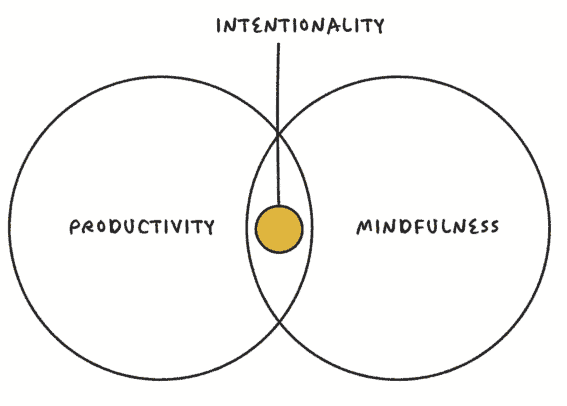
Productivity
One possible explanation for our productivity slowdown is that we’re paralyzed by information overload.
It stands to reason, then, that we need a way to stem the tide of digital distractions to be more productive. Enter the Bullet Journal, an analog solution that provides the offline space needed to process, to think, and to focus.
When you open your notebook, you automatically unplug. It momentarily pauses the influx of information so your mind can catch up. Things become less of a blur, and you can finally examine your life with greater clarity.
The Bullet Journal will help you declutter your packed mind so you can finally examine your thoughts from an objective distance.
Mindfulness
Mindfulness is the process of waking up to see what’s right in front of us. It helps you become more aware of where you are, who you are, and what you want.
Why analog and not digital?
The act of writing by hand draws our mind into the present moment on a neurological level, unlike any other capturing mechanism.
Knowing where you are begins with knowing who you are.
Intentionality
Through Bullet Journaling, you’ll automatically form a regular habit of introspection where you’ll begin to define what’s important, why it’s important, and then figure out how to best pursue those things. You’re gently reminded of these insights every day, which makes it easier to put them into action wherever you happen to be, be it a boardroom, classroom, or even emergency room.
It will empower you to go from passenger to pilot through the art of intentional living.
The Bullet Journal method acts as a bridge between your beliefs and your actions by integrating into the nitty-gritty of your life.
The first part of the book is about how to Bullet Journal. The latter parts are about why to Bullet Journal.
The Why
We want to live an intentional life, and to do this we need to know what interests us, what we believe in. We can create a successful business but if we not passionate about it, once we are there we could be left feeling empty.
Intentionality is the power of the mind to direct itself toward that which it finds meaningful and take action toward that end.
If intentionality means acting according to your beliefs, then the opposite would be operating on autopilot. In other words, do you know why you’re doing what you’re doing?
We can’t be true to ourselves if we don’t know what we want and, more importantly, why so that’s where we must begin. It’s a process that requires the steady cultivation of our self-awareness.
As we begin to identify the things we’re drawn to, we can start properly defining our dreams, based on what we actually believe in.
You can view your Bullet Journal as a living autobiography.
It encourages you to learn from your experiences. What worked, what did not, how did it make you feel, what’s the next move? Day by day, you’re deepening your self-awareness by becoming a steady witness to your story.
Decluttering your mind
We are bombarded with decisions in everyday life. Every decision we make has a biological price to pay. Time is one of our most valuable resources.
We need to reduce the number of decisions we burden ourselves with so we can focus on what matters.
The Mental Inventory
This is just a quick exercise, and it can be done on a piece of paper. One way to combat decision fatigue is to get some distance from all the choices weighing you down.
Just like when organizing a closet, we need to take everything out before we can decide what stays and what goes.
Creating a mental inventory is a simple technique that will help you quickly take stock of what you’ve been jamming into your mental closet.
Create a list like so:
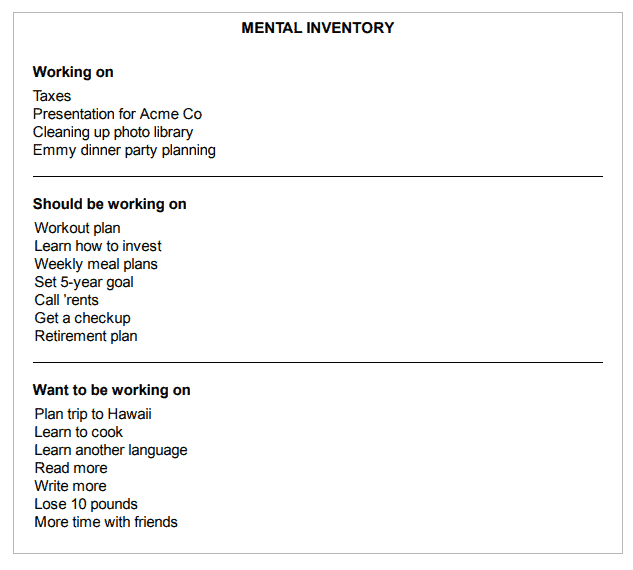
The Test
Go down this list and ask yourself the following questions:
- Does this matter? (To you or to someone you love)
- Is this vital? (Think rent, taxes, student loans, your job, etc.)
If you struggle to answer these questions about a given item, ask yourself what would happen if said item just didn’t get done. Ever . Would there be any real repercussions?
When you’re done, you’ll probably be left with two types of tasks: things you need to do (your responsibilities) and things you want to do (that is, your goals).
Handwriting = Analog
The complex tactile movement of writing by hand stimulates our minds more effectively than typing. It activates multiple brain regions simultaneously, imprinting what we learn on a deeper level.
The fact that it takes longer to write things out by hand gives handwriting its cognitive edge.
The inefficiency of writing can actually benefit us and make us slow down and be selective in what we need to write as opposed to typing.
II. THE SYSTEM
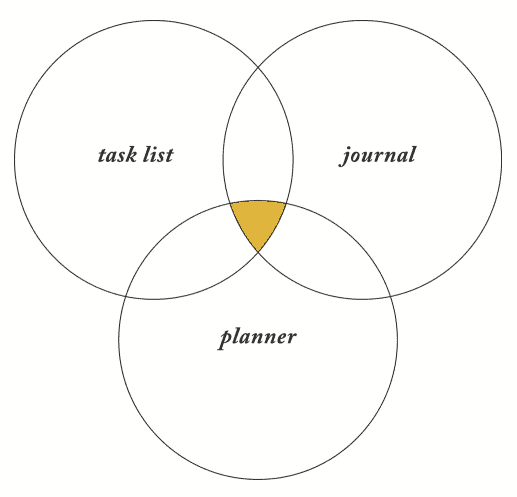
Your Bullet Journal can be your to-do list, journal, planner, sketchbook, or all of the above, all in one place. This flexibility stems from its modular structure.
An easy way to conceptualize the system is to imagine the pieces of a Lego set. Each piece of the Bullet Journal’s system serves a specific function, be it ordering your day, planning your month, or tackling a goal.
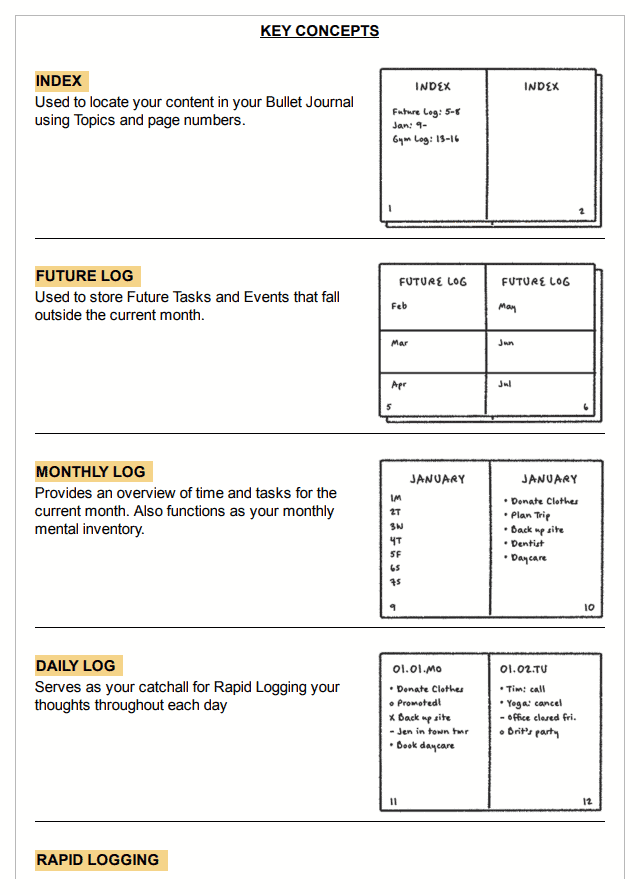
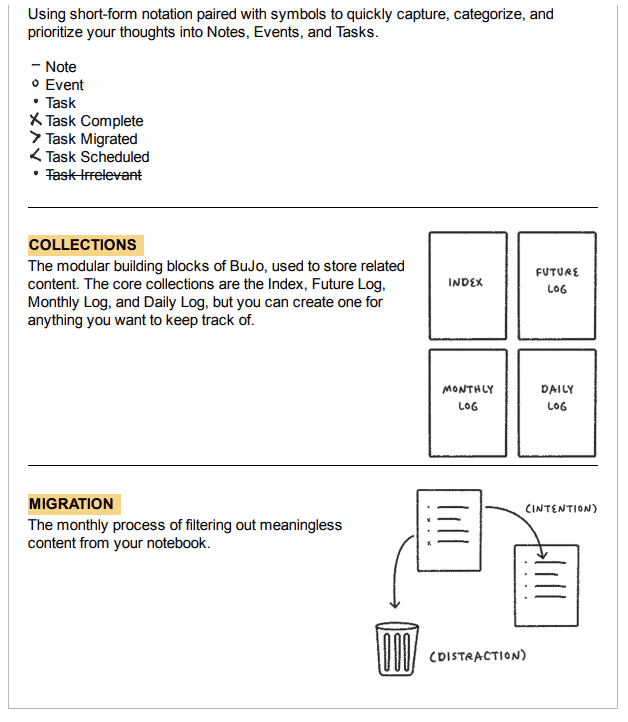
Rapid Logging
Rapid Logging leverages the best aspects of journaling by stripping away everything that’s not essential. It helps us capture and organize our thoughts as living lists.
Rapid Logging will help you efficiently capture your life as it happens so that you may begin to study it.
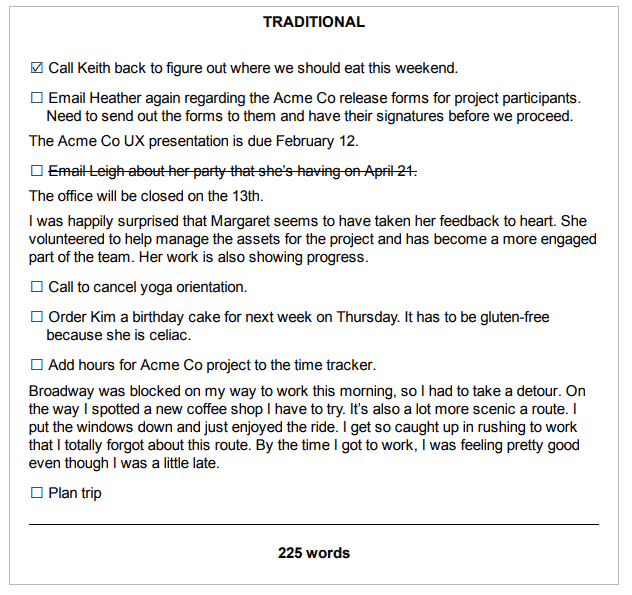
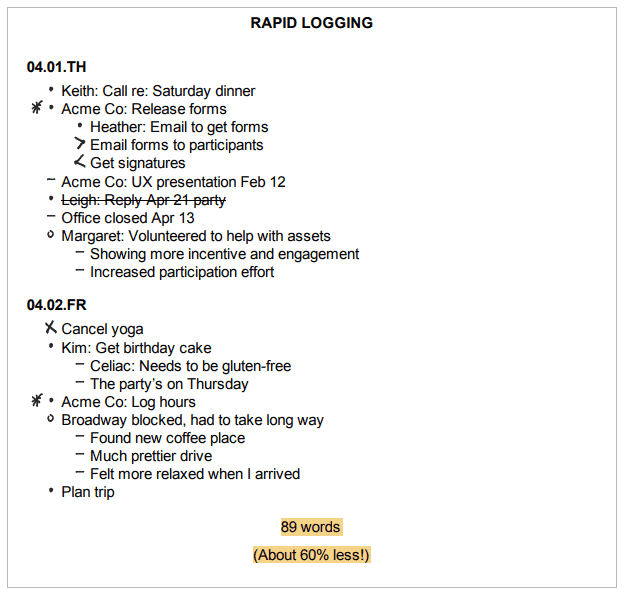
Topics and Pagination
The first step in Rapid Logging is to frame the content you’re about to log. You do this by giving your page a Topic name. It can be as simple as “Shopping List.” Topics actually serve three functions:
- They identify and describe content.
- They serve as an opportunity for you to clarify your intention.
- They set the agenda for the content.
Giving your page its Topic provides that opportunity to pause.
What will you capture in this space?
What’s its purpose?
What value will it add to your life?
Often all it takes to live intentionally is to pause before you proceed.
Page numbers will be critical when we get to Indexing.
The only time we don’t use a descriptive Topic is for our Daily Log – the date will suffice.
Bullets
Each Bullet is paired with a specific symbol to categorize your entry. We use Bullets not only because it takes less time but also because wrestling information into short sentences forces us to distill what’s most valuable.
It forces us to strike a balance between brevity and clarity.
Rapid Logging solves this issue in a few ways, first by categorizing entries into:
- Things that you need to do (Tasks)
- Your experiences (Events)
- Information you don’t want to forget (Notes)
Tasks “·”
The Task “ ·” bullet is fast, clean, and flexible. It can easily be transformed into other shapes, which is important because Tasks can have five different states:
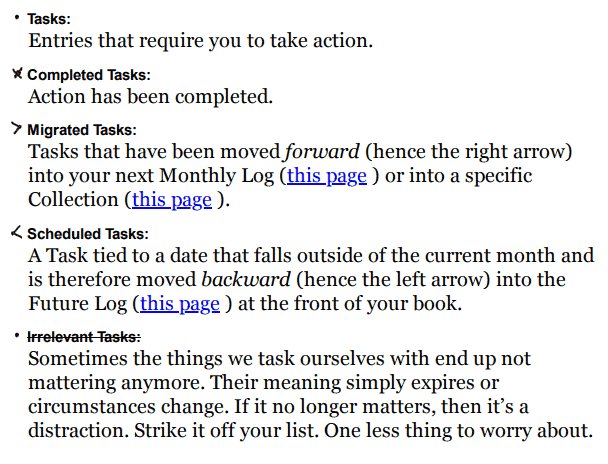
Subtasks can be indented and if to many start forming it may be a good idea to create a new collection for it.
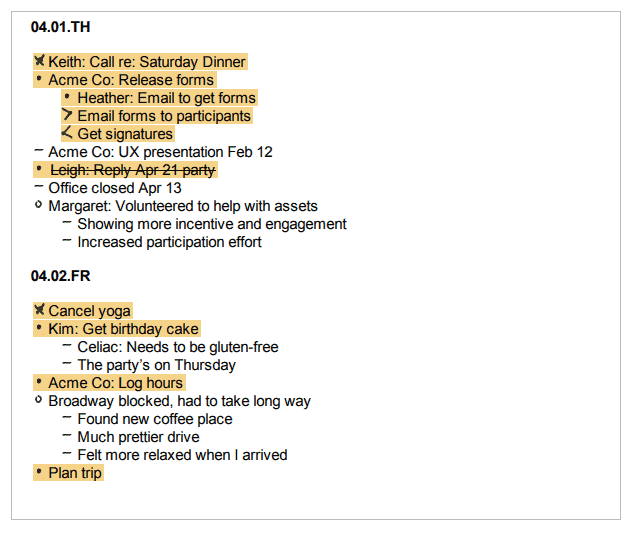
Events º
Events—represented by the “º” bullet—are experience-related entries that can either be scheduled preemptively (for example, “Charlie’s birthday party”) or logged after they occur (for example, “Signed the lease. Yay!”).
They should remain as objective as possible, not having to articulate to much makes us more likely to write it down.
Event bullets allow you to put a pin in an experience, to temporarily offload it from your mind, so you can refocus on other priorities.
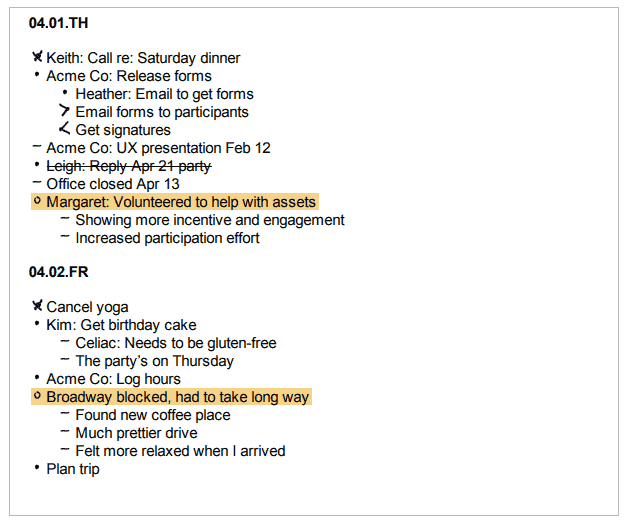
Notes –
Represented with the “– ” dash, Notes include facts, ideas, thoughts, and observations. They log information you want to remember that isn’t immediately or necessarily actionable.
Ask yourself whats important and why?
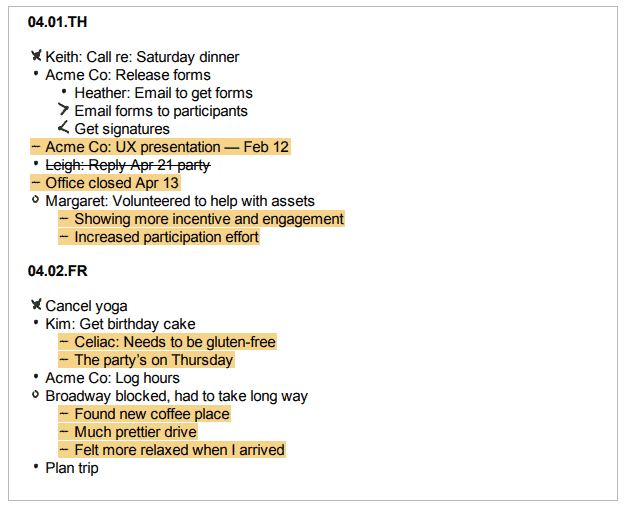
One simple way to summarize all these tips is this: Keep your future self in mind. Your Notes will be useless if they can’t be deciphered in a week, month, or year from now.
Signifiers and Custom Bullets
Signifiers
These are symbols used to highlight specific entries to give them additional context. Signifiers are placed in front of bullets so they stick out from the rest of your list, making them easy for the scanning eye to locate.
Priority: Represented by “*” asterisk. Used to mark a bullet as important. Use this sparingly. If everything is a priority, nothing is.
Inspiration: Represented by “!” exclamation point. Most commonly paired with a Note. Great ideas, personal mantras, and genius insights will never be misplaced again!
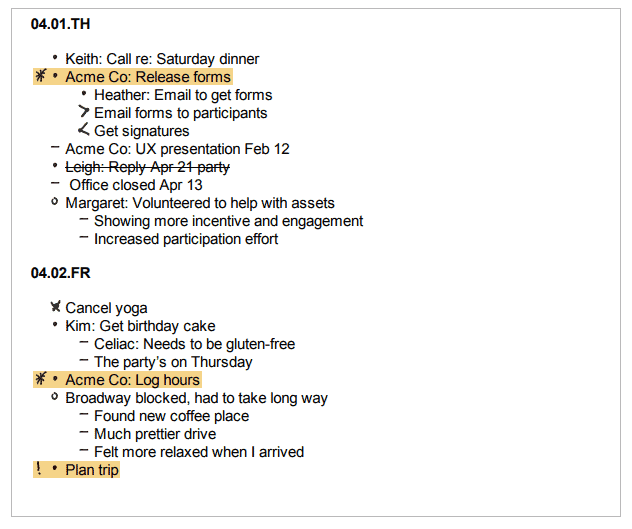
Custom Bullets
You can create your own custom bullets according to your own needs if you find yourself creating a lot of a specific task.
Keep custom bullets and tasks to a beat minimum. Less friction.
Collections
There are four core Collections: the Daily Log, the Monthly Log, the Future Log, and the one Collection to rule them all, the Index.
These will serve as the foundational structure for your notebook.
The Daily Log
The idea is to be consistently unburdening your mind.
Your Daily Log is more than a simple to-do list. Yes, it serves to capture your responsibilities, but it also helps you document your experiences. It’s a safe place where your mind is free to express itself, judgment-free and always happy to welcome your thoughts as they bubble up throughout the day. It acts as a catch-all for everything else in the journal.
Over time those thoughts become a record of your state of being, which becomes incredibly valuable when we get into Reflection. It provides the context we often lack in our daily lives. With context, we can be more deliberate with our actions.
This could be useful to do in combination with your life OS, write down the most memorable event from that day.
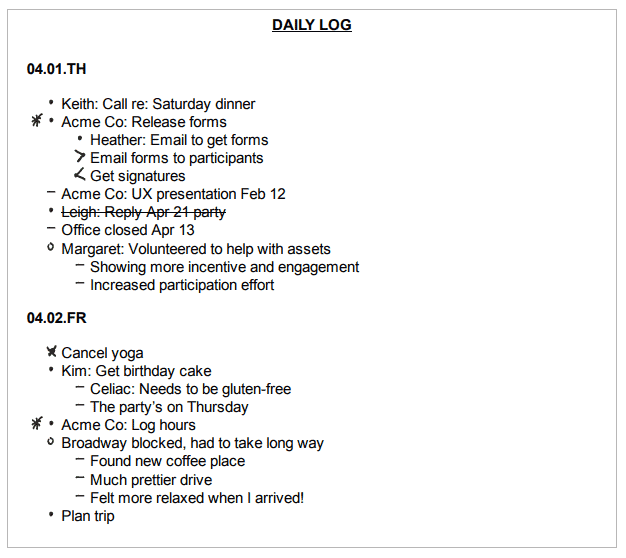
The Monthly Log
It offers a bird’s-eye view of the things you have to do, as well as your available time. If each Bullet Journal is another volume in the story of your life, then the Monthly Log marks a new chapter.
Setting them up allows us to regularly check in with ourselves so that we can maintain/regain context, motivation, and focus.
The Monthly Log is set up on a spread of facing pages. The left page will be your Calendar page; the right page will be your Tasks page. The Topic of this Collection is the name of the month, and we add it to both pages of the spread.
Calendar Page
List the dates of that month down the left edge of the page, followed by the first letter of the corresponding day of the week.
Signifiers will allow you to quickly scan your Calendar page to find anything noteworthy.
Feel free to use this page like a traditional calendar by slotting in your Events and Tasks ahead of time.
- Keep your entries as short as possible.
- For some added clarity, you can add lines dividing the weeks.
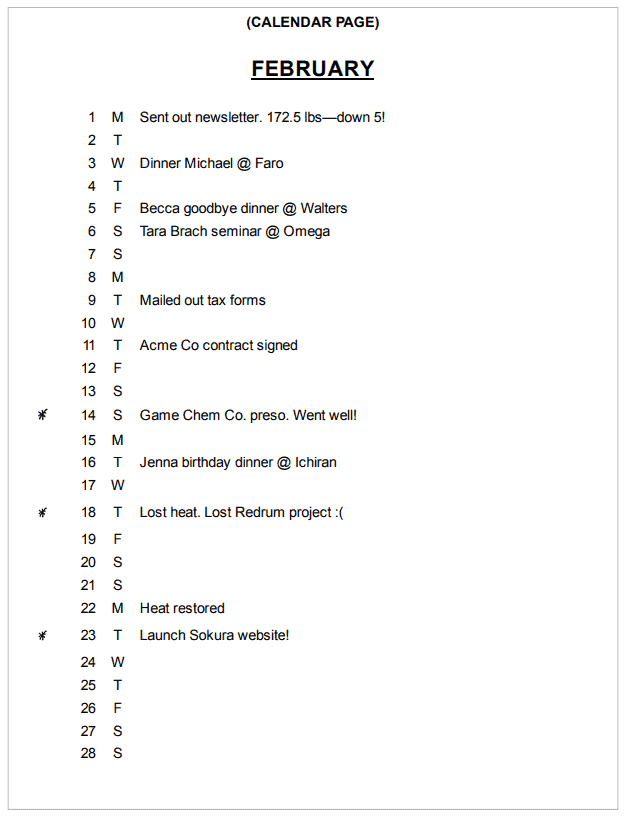
Task Page (or Mental Inventory)
The Tasks page of your Monthly Log will serve as your ongoing Mental Inventory page. Give yourself permission to sit for as long as it takes to offload the action items swimming around your head. What matters this month? What are the priorities?
When you’re done capturing your thoughts, go through the previous month and see what Tasks remain open. Transfer any important items into the new Monthly Log’s Tasks page.
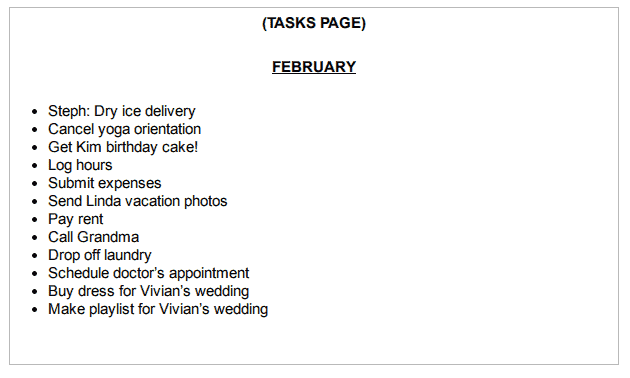
The Future Log
The Future Log stores entries that have specific dates that fall outside of the current month.
The Future Log lives at the front of your Bullet Journal, right after your Index. It usually requires 1–2 spreads of facing pages.
So how does this work in practice? During the day, just continue to write everything down in your Daily Log, even future Tasks.
Again, the Daily Log prevents us from wasting time thinking about where to write things down. It’s a catch-all, designed to hold our thoughts until we’re ready to sort them out.
When that time comes—like during Daily Reflection —you’ll transfer any bullets with a future date from your Daily Log into your Future Log. Once you do, be sure to mark the entry as scheduled “<” in your Daily Log.
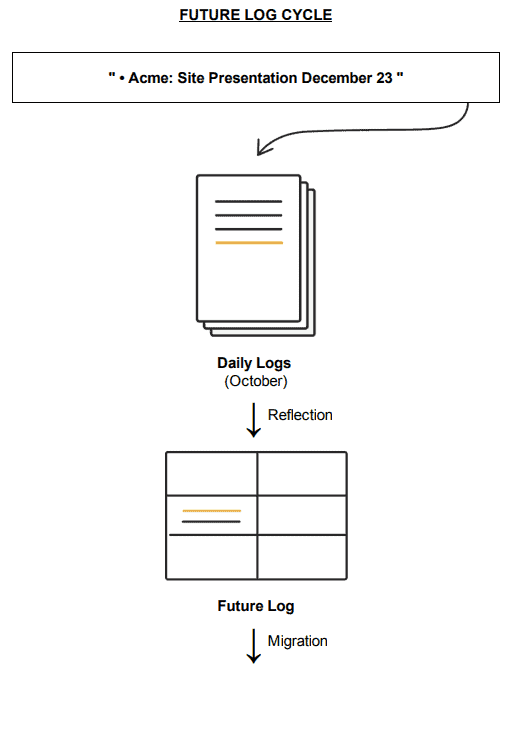
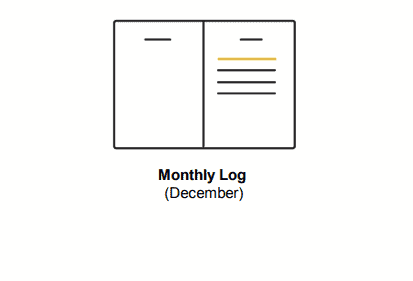
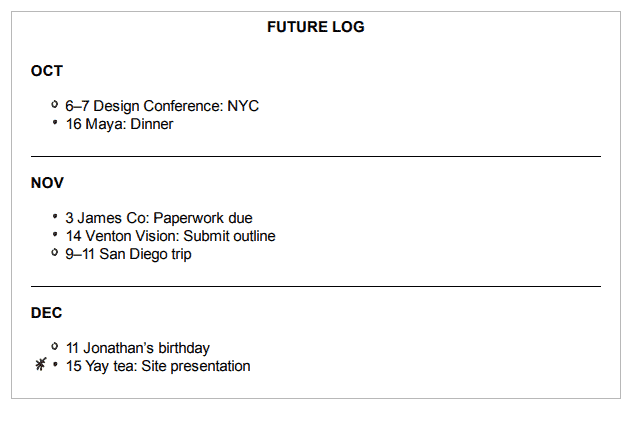
The Index
You can think of the Index as a container that stores all of your other Collections.
Allocate two spreads—four facing pages—for your Index.
To add a Collection to your Index, simply write down the Collection’s Topic and page numbers.
Life is unpredictable and because of this don’t worry about making it consecutive.
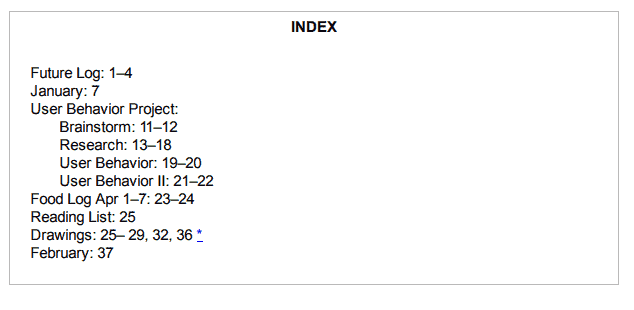
Subcollections
Use subcollections if a project has a lot of moving parts, ie. User Behaviour.
Dedicated Index
Use a dedicated page if your journals focus on a specific subject matter.
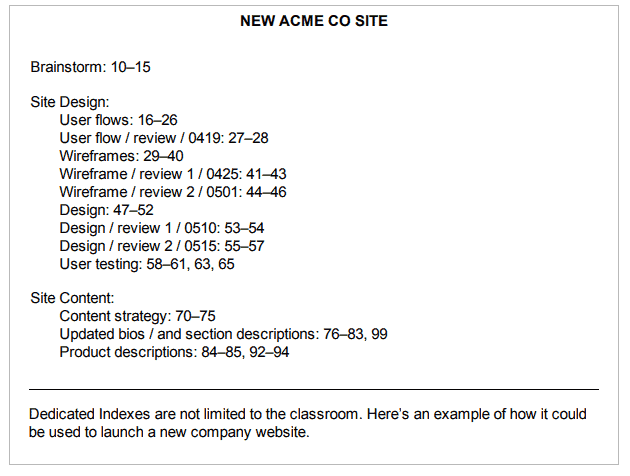
Threading
Threading enables us to link instances of related content together without having to refer to the index the whole time. It happens directly on the page in review. You write down the instances next to the current page numbers.
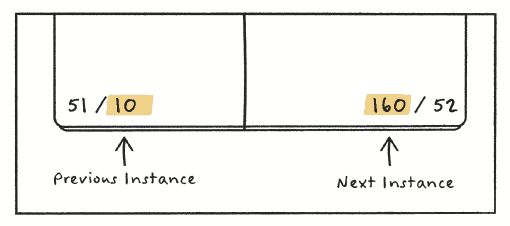
If you want to reference from another journal volume you use a “.”
i.e. 2.34 is volume 2 and page 34.
Migration
During Migration, we transfer content from one place in our Bullet Journal to another by rewriting it. This may seem like a lot of effort, but it serves a critical purpose: It weeds out distractions.
We have to pause and consider each candidate. Do we really need it?
Productivity is about getting more done by working on fewer things.
Migrating (rewriting) each item from the Daily Log options: ➡️
- Tomorrows Daily Log
- Monthly Log
- Future Log
- Delete it if not important anymore
Monthly Migration
The main Migration happens at the end of every month, when you’re ready to set up a new Monthly Log.
Slowly scan all of the pages of the past month, reviewing the state of your Tasks. Transform any guilt into curiosity by asking yourself why each Task might still be incomplete.
Does it matter? Is it vital? What would happen if you didn’t do it?
If a task has become irrelevant, strike it out.
If a Task remains relevant and adds value to your life, then migrate it. You can migrate an item in three different ways:
- Transcribe the open Task to the Tasks page of your new Monthly Log (this page ). Then mark the old entry as migrated “>”.
- Transcribe the Task into a Custom Collection. Then mark the old entry as migrated “>”.
- If the Task is date-specific and falls outside of the current month—migrate it into your Future Log. Then mark it as scheduled “<”.
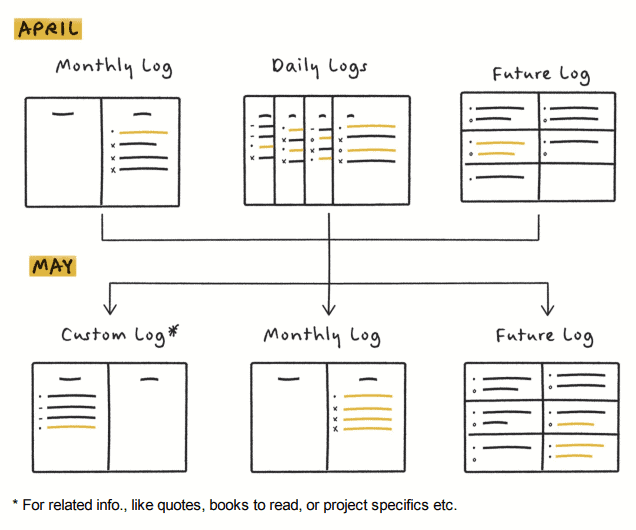
Quick Set up
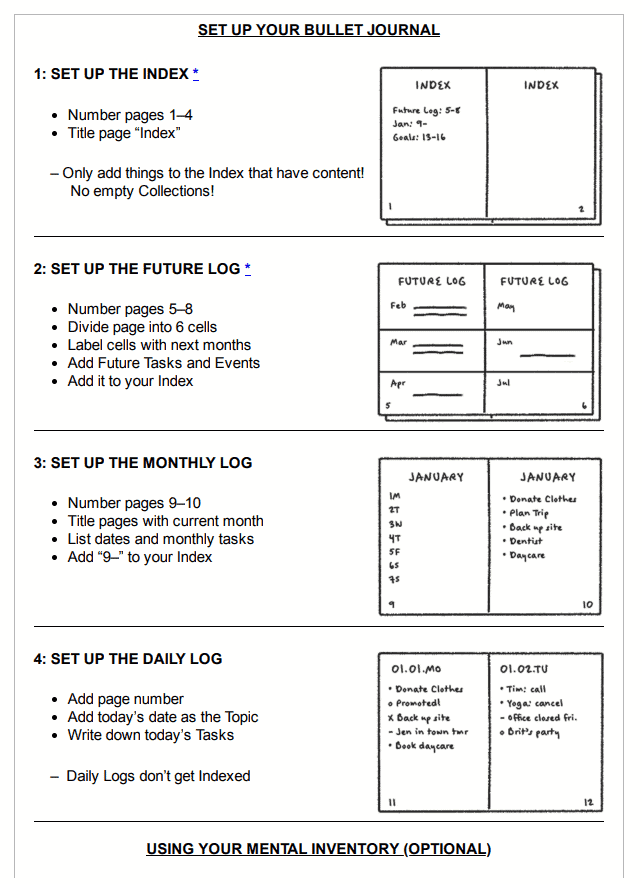
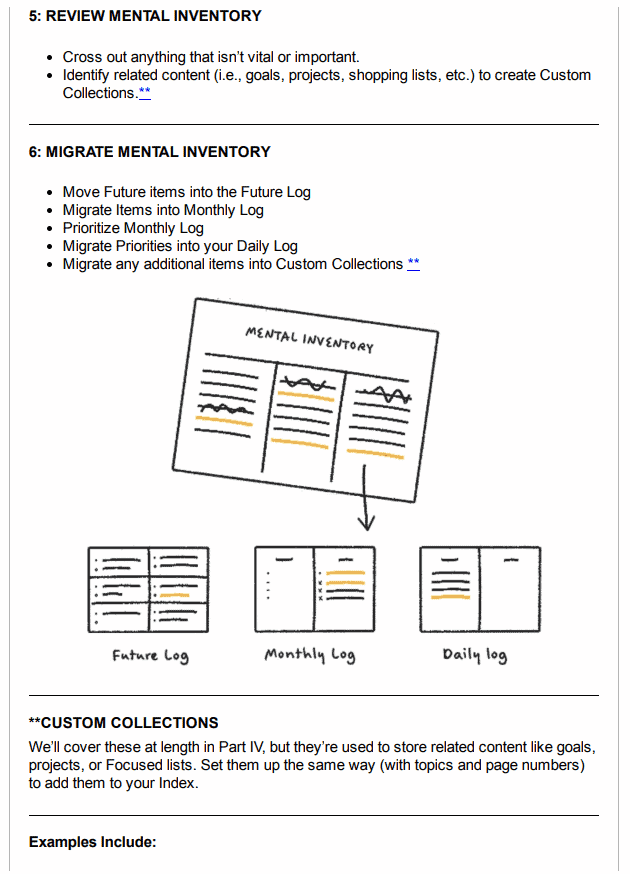

III. THE PRACTICE
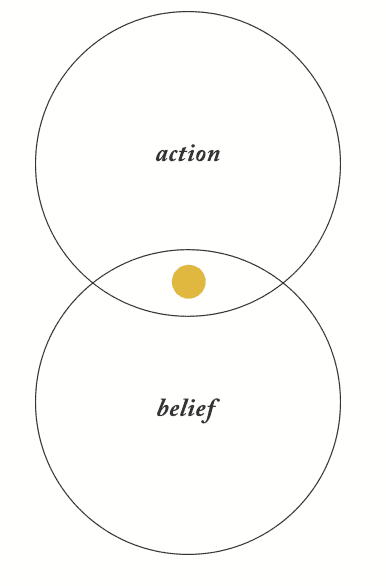
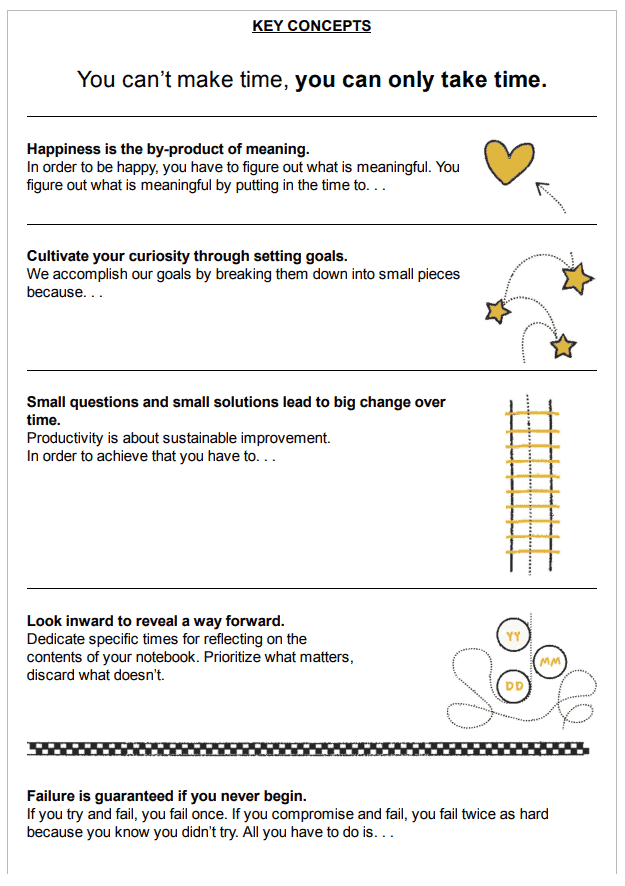
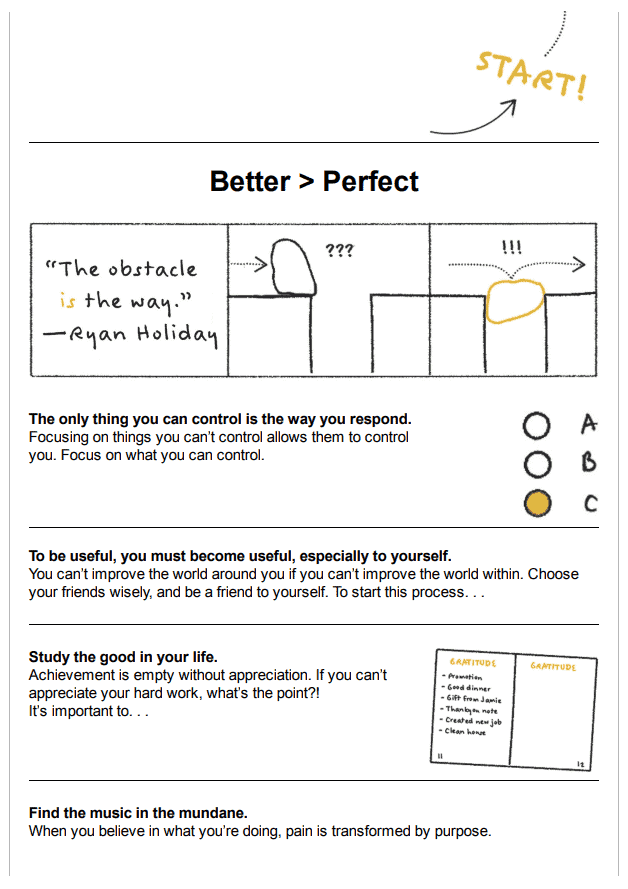
Reflection
Reflection is the nursery of intentionality. It grants us the protected mental environment we need to reclaim some much needed perspective and begin to ask why . Through Reflection, we cultivate the habit of checking in with ourselves to examine our progress, our responsibilities, our circumstances, and our state of mind.
Reflection helps identify what nourishes you so you can make better decisions as you seed the next season of your life.
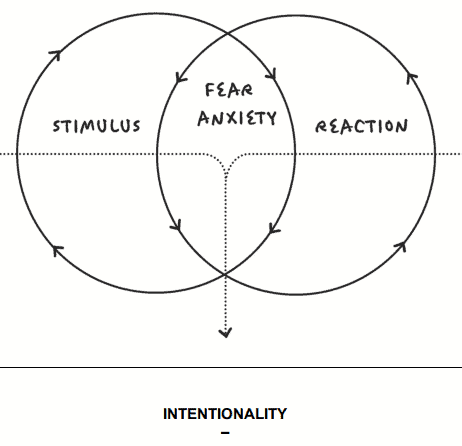
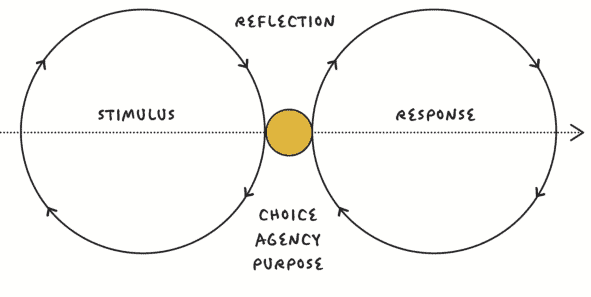
By keeping a log of your responsibilities and thoughts, you are passively reflecting, when you sit down and reflect on them is when you turn that into active reflection.
Daily Reflection
Throughout the day, you’re capturing your thoughts using your daily log. You then come back to them, to bookend each day with two dedicated times of active introspection.
AM Reflection: A Time to Plan
Before you dive into your day, sit down with your journal. Review all the pages of the current month and remind yourself of any open tasks.
This helps you focus and clarify your priorities and plan accordingly. You’ll step into your day with confidence, clarity, and direction.
PM Reflection: A Time to Review
Before you go to bed, sit down with your Bullet Journal and scan what you’ve logged throughout the day. Mark completed Tasks with an “X.” If a Task is missing, write it down. Again, you’re unburdening your mind.
Once your journal is updated, bring your attention to each item individually. Here’s where you begin to ask:
Why is this important?
Why am I doing this?
Why is this a priority?
And so on. This will help you surface distractions. Strike out the Tasks you’ve deemed to be irrelevant.
This is a great way to decompress the day before you go to sleep, relieving stress and anxiety through a sense of progress and purpose.
Monthly and Yearly Reflection Through Migration
Migration is designed to add the friction you need to slow down, step back, and consider the things you task yourself with. On the surface it’s an automatic filtering mechanism designed to leverage your limited patience.
In addition, handwriting triggers our critical thinking, helping us draw new connections between thoughts. As you migrate each item, you give yourself a chance to identify unconventional relationships or opportunities by holding each item under the microscope of your attention.
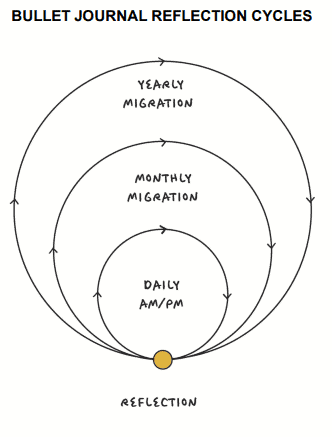
You dont need to spend a lot of time on the journal but keep it consistent.
The goal is getting into the habit of checking in with yourself, asking small whys .
We increase our awareness by slowing down and checking in with ourselves.
Meaning
To live a happy life is to live a meaningful life. We need to find what truly makes us happy and the goals we need to set to achieve that. Happiness itself is not a goal, but taking the time to understand what our goals ultimately do for us is important to living that meaningful life.
If happiness is the result of our actions, then we need to stop asking ourselves how to be happy . Rather, we should be asking ourselves how to be .
Exercise
This exercise will give you a perspective of what might be meaningful in your life.Think of two paths, a fork in the road, if you will.
The well-worn path This path leads you toward the familiar. It favours comfort over risk. It is a continuation of your current life. You simply move along in whatever pursuits are comfortable for you, putting little effort into changing your lesser qualities or striving for improvement. At the end of this life, what will you have accomplished, personally and professionally? What are the consequences of this life?
The path less travelled This path leads you into the unfamiliar. It’s a life that favours risk over comfort. You dare to pursue the things that interest you and actively work to improve yourself. At the end of this life, what will you have accomplished, personally and professionally? What are the consequences of this life?
• • •
Now, for each path, take 15 minutes or more to write your obituary based on having taken that path. Create a “Two Lives” Collection and add it to your Index. Start with one spread for one path. Set up the second spread only when you’ve completed the first.
Fill in as many pages as you need. Dig deep. Be honest. This is for your eyes only. What do you see as you look far down each path?
Postmortem
- Read through both obituaries. On the next page in your notebook, write yourself a letter. What realizations, emotions, questions, positives, or negatives came up during the exercise? What surprised you? What saddened or scared you? What excited you?
The point is to capture how you feel about seeing your whole life flash before your eyes. Phrase it in a way to remind your future self—the one who will be reading this later —what shifted because something definitely will. Remind yourself what you’re trying to get away from and where you want to go. - Select the life you liked best, and identify and circle the accomplishments that you’re most proud of. Once you’re done, migrate these items into a “Goals” Collection. Just like that, you’ve taken your first step toward realizing a more meaningful life on your own terms.
Goals
Goals need to be authentic and meaningful to withstand the bumps along the way.
Perseverance and passion are the two keys to keep in mind. Don’t create vague goals or goals that are technically out of your control. This might set you up for failure.
If you want a million dollars, ask yourself why? Go deeper, maybe to be able to pay for schooling, travelling, comfort and provide for your family.
Create a goals collection in your journal. Big or small, just write them down here so you have them clearly contained in one reusable place.
The 5,4,3,2,1 Exercise
The 5, 4, 3, 2, 1 exercise is designed to help you contextualize your goals in terms of time. It will quantify your objectives by breaking them down over the short, mid, and long term.
First, turn to your next blank spread. The Topic for this new Collection will be “5, 4, 3, 2, 1.”
Divide the spread into five rows on each page. The left page will be for your personal goals; the right page will be for your professional goals. The top cell will store the goals you want to accomplish in 5 years. In the next cell, you’ll have goals you want to achieve in 4 months; the next cell will be for goals to achieve in 3 weeks; the next cell will be for goals to attain in 2 days, and the final cell will be for goals you intend to accomplish in the next 1 hour.
Now turn back to your “Goals” Collection and migrate your goals into their appropriate cells.
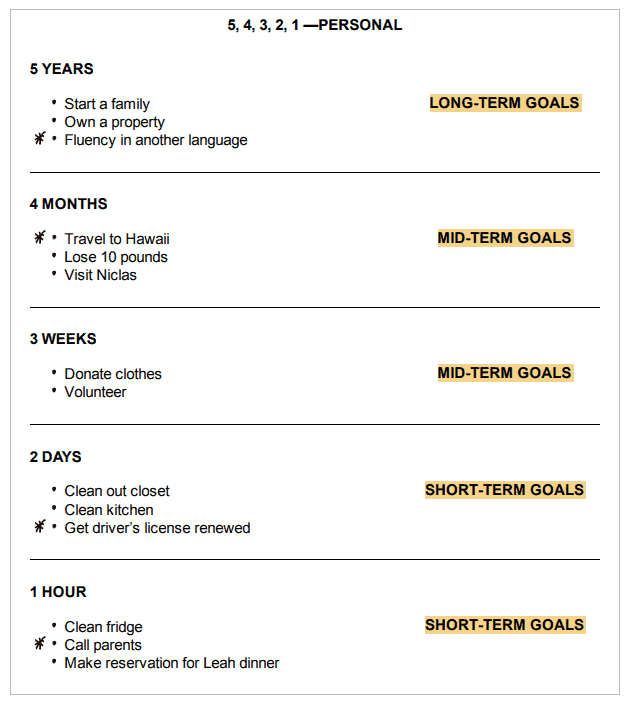
Prioritize your goals
Prioritize one from each period and then transfer them to the relevant logs or, for the longer ones, create a new collection.
Focus on your priorities
Keep this in mind when picking your goals: What do you want to put into your life now—and, more importantly, why?
Breakdown your goals into sprints
Sprints help protect us if we feel like something isn’t worth it anymore; because of the sprint, we don’t invest to much time and effort into something.
Breaking down long-term goals into smaller, self-contained goals can turn what seems like a marathon into a series of Sprints. Sprints cover the same ground, just in shorter, more manageable intervals.
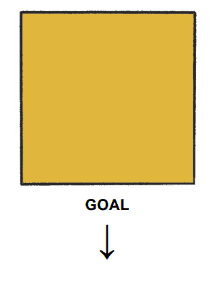
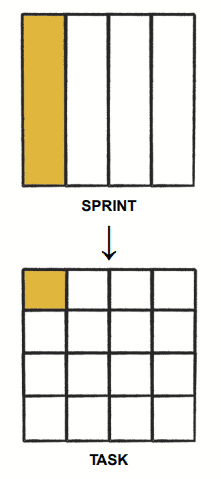
Breaking down goals into Sprints mitigates the risks of being overwhelmed and fatigued.
How are Sprints different from just dividing a goal into phases? Unlike phases, which are not ends in themselves, Sprints are independent, self-contained projects—thus the outcome is, let’s hope, a source of satisfaction, information, and motivation to keep going (or, as happened with my stop-motion animation project, a helpful cue to let this particular goal go).
To set up Sprints, structure them around specific subset goals or skills needed for a longer-term goal. To return to the cooking analogy, here’s how that might look:
LONG-TERM GOAL: LEARN HOW TO COOK
Possible Sprints: Learn knife skills Learn how to sear and sauté [adding Tasks for other methods as you go] Learn how to select fresh vegetables [levelling up to Tasks for selecting fruits, meats, poultry, etc.] Learn how to cook eggs [setting up related Tasks one by one: hard-boiled, scrambled, over easy, an omelette]
Good Sprint Requirements:
- Have no major barriers to entry (nothing preventing you from starting).
- Consist of very clearly defined, actionable Tasks. Your knife skills might be broken down into holding a knife properly, sharpening, peeling, slicing, dicing, cubing, mincing, and so on.
- Have a fixed, relatively short time frame for completion (should take less than a month to complete, ideally a week or two).
The point is to safely indulge your curiosity and try things on for size, without wasting time.
Brainstorming your goals
Before we can break down our goal, we have to wrap our head around it. Now that you’ve picked your goal and created a Collection for it in your Bullet Journal, use the first spread to brainstorm the what and the why. Write down whatever comes to mind. This process gets your gears turning.
Suppose your “Learn to Cook” goal brainstorming page looks like this:
- What about this goal sparked my curiosity? I’ve always wondered how foods go from just sitting in the store to being a beautiful, nutritious meal on a plate. What happens, exactly?
- What motivated me to want to invest my time and energy here? I’m spending a lot on take-out and prepared foods, and I know it’s not the healthiest way to eat. I’ve gained a little weight lately and want to watch my calories.
- What am I trying to accomplish? By learning to cook, I can save money and eat more healthfully, and I hope to lose a few pounds. I also want to be able to invite friends or a date over for a meal and not worry about screwing things up.
- What will it require? Learning basic food-prep skills, basic cooking skills, and some easy go-to recipes for my own meals and a few crowd-pleasers like chilli, soup, or burgers.
- What is my definition of success with this goal? Spending less on take-out and prepared foods, healthier diet, and having friends over for dinner.
When you’re done brainstorming, you should have a better idea of your goal’s requirements: its scope, its milestones, and why it’s important to you. Now break it up into Sprints. Each Sprint can be laid out in another Subcollection.
Traditional / Phased Model
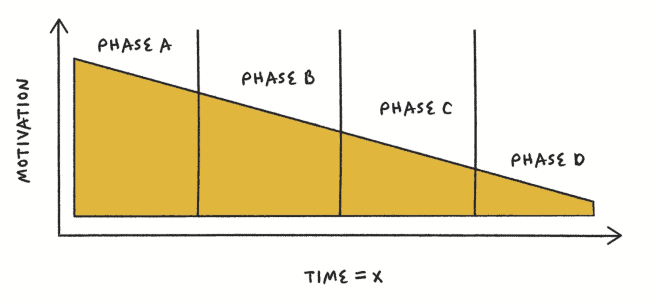
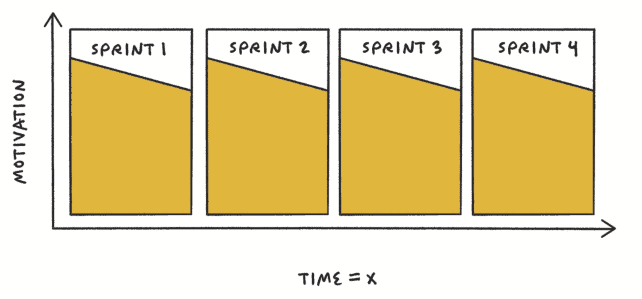
The longer a goal takes to accomplish, the more it taxes your motivation. When motivation runs dry, goals tend to crumble.
Sprint projects will help you reduce the load so you can enjoy the satisfaction of seeing regular progress in self-contained chunks.
Progress provides momentum. Momentum helps you cultivate your patience. Successful or not, Sprints provide you with room for reflection.
Small Steps
Let’s take these Sprints and break them down into actionable steps or Tasks. Create your Tasks through the lens of curiosity rather than by giving yourself commands or ultimatums. It’s the difference between “Lose weight!” and “What one unhealthy thing could I remove from my diet?”
Our minds respond well to questions because we’re problem solvers. You can engage your curiosity by asking yourself questions to spark your imagination:
What do I want to do? Why do I want to do it? What small thing can I do right now to get started?
What small step can I take now to move this forward? What could I improve now?
Time
The quality of our time is determined by our ability to be present.
Time Boxing
Timeboxing quarantines an activity to an allotted slot of time. It’s designed to bring your full attention to something by only allowing you to focus on it for a predefined period of time.
Timeboxing adds two key motivational ingredients to a Task you’ve been putting off: structure and urgency. Preschedule chunks of tasks ahead.
Scheduling – Front load the difficult, unenjoyable tasks in your day to free your mind. The rest of the tasks will be things you look forward to in the day giving you more energy.
Memento Mori – We all die eventually; with this in mind, we need to remind ourselves and make the most of our time.
Gratitude
Celebration – Your journal is filled with tasks. Once you complete a task, cross it off the list. You will feel a sense of accomplishment. Take the time and celebrate your accomplishments.
Gratitude Practice – Having a gratitude practice has been shown to improve relationships, physical and mental health, empathy, self-esteem, and lowering aggression.
- In your daily log, during your PM reflection, write down more than one thing you are grateful for.
- Create a “Gratitude” Collection. Every day add to the collection.
It will help you remain aware of the things that make life a little more enjoyable. Every day, once a day, give yourself the present of savouring the good in your life.
Control
We can’t control our feelings, people, or external events. But there is something we can control, and it’s powerful.
We can control how we respond to what happens to us.
Process vs Outcome
During your Daily Reflection or Monthly Migration, scan your Tasks and try to identify what is and what is not in your control. You can tell this if they are more focused on outcomes rather than process. Ie.
Read five books (outcome) rather than, set aside 30min reading time (process).
Focus on what we can control and let go of the rest. That way, we can put our attention to the things that matter.
Radiance
The ability to influence the world around us is our radiance—literally, what we radiate. An example is if we hold the door open for someone, it creates a ripple effect for that person to be nice to someone else.
Self-compassion
We’re happy to offer support and solace to those we care for. What if we extended this same kindness to ourselves?
Self-compassion can start by asking yourself a simple question: What would I tell a friend in this situation?
When you are down, show yourself some of the positives recorded in your reflection pages to remind yourself of the good.
Mutual Improvement
Radiance is a two-way street. So be mindful of the people you surround yourself with because they will shape you.
It’s good practice to see who you spend your time with and how they make you feel.
When you record events you attend, include notes on how you felt and other takeaways when spending time with someone. You can reflect on the positives or show signs of a toxic relationship.
Learning
The best way for your radiance to serve others is to challenge yourself to grow. To that end, make deliberate learning an ongoing focus of your life.
During your Reflections, ask yourself:
What am I learning? What lessons has ________ [situation or relationship] taught me or inspired me to learn? What do I want to know more about?
How will I go about learning it?
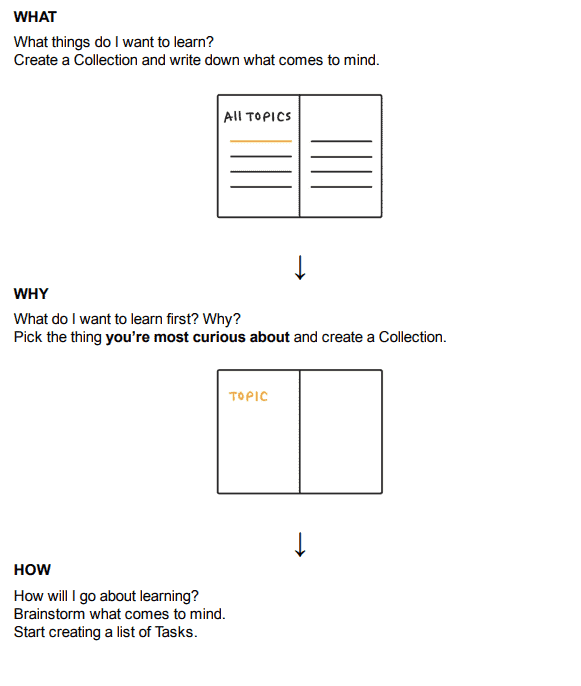
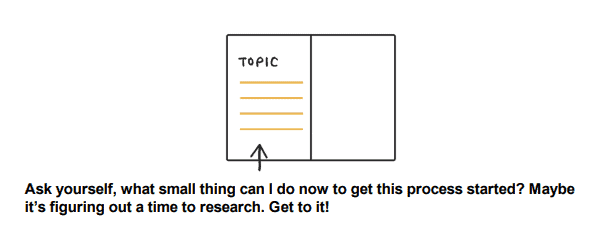
Endurance
We often act without conscious thought. We make our way through life on autopilot, seldom stopping to understand why something makes us feel the way it does. Without personal context, without understanding how something adds value to your life, your efforts will ultimately feel meaningless. Context helps us understand how something unpleasant or even painful responsibilities actually benefit us. Ie. doing the dishes could be a form of meditation to some.
Clarity Log
This is not about positive thinking; it’s about systematically analyzing your efforts to define their purpose. We don’t tend to contextualize our obligations this way. To help us become mindful of why we’re doing what we’re doing, we can create a “Clarity Log” in the Bullet Journal. Scan your Daily Logs and identify the obligations or chores that you struggle with the most.
Take one and write it down on the left page of your Clarity Log.
On the right-hand side, balance the negative feeling with the positive and the purpose of why we do what we do.
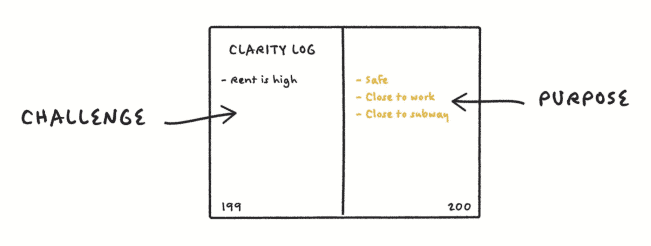
Deconstruction
We often exaggerate our problems. No matter how serious a problem may be, we tend to make it seem worse than it really is.
Even the smallest action can start changing our circumstances. The first action can be simply pausing to examine your problem so you can begin to deconstruct it.
We can use the “The Five Whys” technique
It breaks down seemingly large problems into smaller components.
Start a new Collection and give it a Topic that names the problem: “I can’t pay rent.” Now ask yourself why? Write down the answer.
Now, challenge your answer by asking why again. Do the same for the next answer, and so on, up to five times.
Example:
I CAN’T PAY RENT.
- Why? Because I don’t have the money.
- Why? Because the rent is high.
- Why? Because I live in a nice area.
- Why? Because I like living there.
- Why? Because the neighbourhood has nice people, good shops and restaurants, and makes me feel safe.
We can target them individually and devise our strategy accordingly.
- Ask for a raise.
- Look for a better-paying job.
- Get a roommate.
- Move to a different neighbourhood where the cost of living is lower.
- Take continuing education classes to increase your value.
Let’s say you chose “Take continuing education classes to increase your value.” That’s your goal. Flip to the next blank spread and create a subcollection dedicated to this goal.
With your goal set up, break it down into actionable steps like researching fields of interest, finding different schools offering classes, signing up for a class, and so on. This is your plan of attack. Each Task you complete is a successful blow landed in the battle with your dragon.
Inertia
How to get over a problem and get back some traction.
Rubber Ducking
We tend to be less objective when we are stuck. Explaining our problem to someone else helps us to look at it from a different angle, instead of from the depths of the difficult situation we have created.
If you’re alone, take a moment to sit with your Bullet Journal and write a letter to someone you trust, like “Dear Duck”. Share your thoughts on:
Your problem What’s not working Why it isn’t working What you’ve tried What you have not tried yet What you want to have happen
Break Sprint
When you’re feeling stuck or lacking inspiration, it often means you’ve lost perspective. You may be too close to the subject to see a way forward. To regain some clarity, take a break and focus on something else.
This is where you can possibly grab something else out of your goals section to tackle.
A break-sprint can be set up in your Bullet Journal the same way as a standard Sprint, but it follows a subtly different set of rules:
It should take two weeks or less to complete. You need a break, but you don’t want to lose the thread of your main project.
It should be unrelated to the project/problem that’s troubling you. You and your main project need space. You’re not breaking up, but you’re taking some much-needed “me time.”
Very critically, it needs to have a defined end (and a clear beginning and middle, too). When we feel stuck, our sense of inertia drains our motivation. One goal of your break sprint is to give you the satisfaction of crossing off the final Task, of feeling that sense of accomplishment and closure.
Reminding yourself what that feels like can quickly refuel your drive.
BREAK-SPRINT Example “PARE DOWN CLOTHES” BREAKING IT DOWN
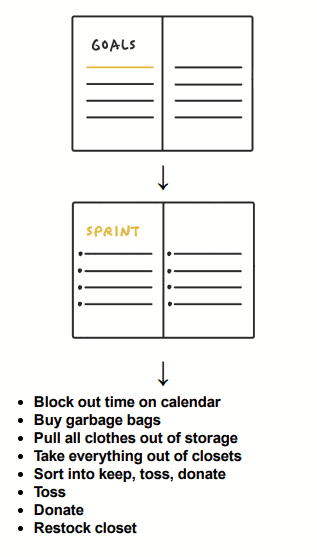
By the end of your break-sprint, you’ll have been exposed to something new. This will help you use your mind in a different way and have thoughts you wouldn’t have had otherwise. Every new experience helps us grow and grants us a new perspective.
Imperfection
In Japan, there is the term wabi-sabi. Wabi-sabi posits that the beauty of an object is found in its imperfection.
Embracing our imperfection puts the emphasis back where it should be: continual improvement. This mindset turns mistakes from land mines into street signs, pointing us toward where we need to go.
Practising Imperfection
Whenever you find yourself fixating on achieving perfection, remind yourself that it’s just a tool. What matters is what you’re creating. By accepting that we can’t be perfect and that failure is inevitable, we can return to our work.
Good Change
We can get better by working hard and practising, instead of trying to be perfect.
Figure out some ways in which you can improve. Then format the answer as a Task or Goal and log it in your Bullet Journal. Each task completed is experience gained. Keep track of your progress. This way you’ll be more likely to actually take action.
IV. THE ART
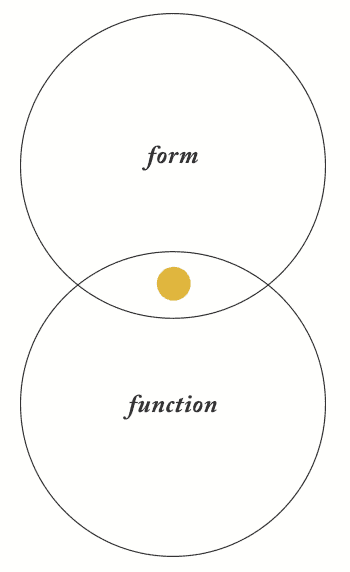
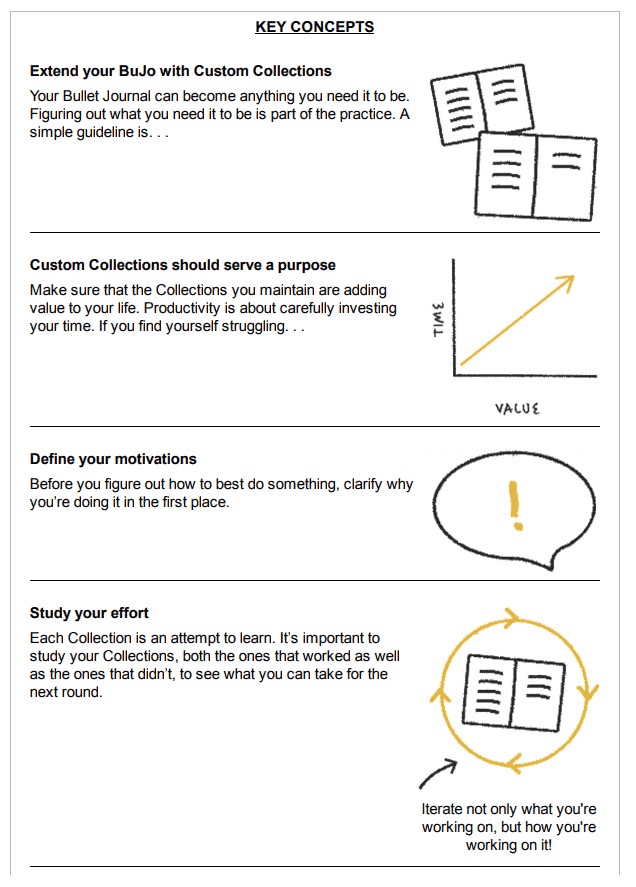
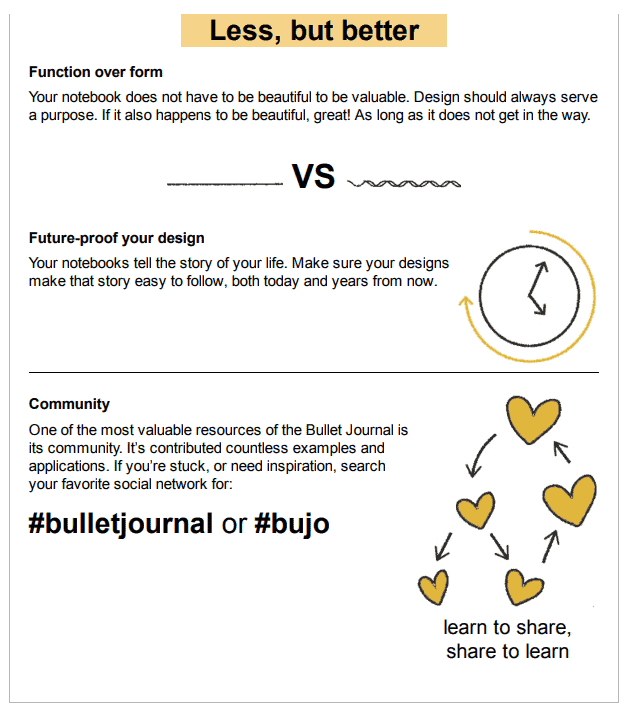
Custom Collections
A Custom Collection is designed to serve a specific need.
If there’s nothing to be learned from the information in a Collection, it provides little value, and chances are you’ll lack the incentive needed to maintain it. Don’t waste your time tending Collections that won’t add value to your life.
Three Key Sources for Custom Collections
- Goals Goals are important because they give us direction and purpose. They can be complicated with lots of parts. Custom Collections can help us break down a goal into smaller pieces so we can work on each part separately.
- Challenges Do you often feel mad, worried, out of control, or hard on yourself? Once you know what the problem is, a Custom Collection specifically for that problem can be helpful. It gives you a special place to put your ideas and keep track of your progress towards a solution.
- Tasks Many Collections begin their life posing as simple Tasks, like “ •Plan vacation!”
First steps to creating a custom collection:
Create a collection page with the relevant topic name.
Brainstorm
Make the first few pages a brain dump about the topic.
These pages are dedicated to capturing initial thoughts, no matter what form they take, be they single words, images, mind maps, etc. This spread is here to unload your ideas, get excited, and see what you can shake loose through free association.
Examine your motivations
Ask yourself, Why are we taking on this project? What need does it address? To have more quality family time? To relax and refresh through surfing and/or forest bathing? Whatever it is, it’s okay. We’re asking just to get the wheels turning so we can unearth the underlying cause of our motivation.
Understanding why you feel compelled to do something will help you better define how to do something.
It can help to write out a brief mission statement to define why we’re doing something, what we hope to get out of the experience, and how we will go about doing it. You can even use this script if it’s helpful:
I want to _____ [what] so that I can _____ [why] by _____ [how].
So, in this case, the mission statement could be:
I want to go on vacation so that I can relax by not being in the office.
Use the Five Whys method to go even deeper. Ie.
- Why do you want to go on vacation? To relax.
- Why? Because work is stressing me out and depressing me.
- Why? Because it’s the same thing day in and day out, and it makes me feel lonely.
- Why? Because my life is confined to my cubicle and my couch, and I don’t get to see the people I care about.
- Why? Because I don’t take time for those things.
We’ve now identified various pain points that we can begin to tackle. Let’s start by highlighting some key themes that have surfaced: confinement, boredom, depression, loneliness, and guilt. These are the likely sources of your motivation. The goal for this vacation would then be to alleviate those pain points by experiencing their opposites: freedom, excitement, joy, connection, and pride. Let’s rephrase our mission statement to address these desires:
I want to go on vacation so that I can remind myself what I’m working for (pride) by spending quality time with people I care about (connection) while we have fun (joy) exploring a tropical place together (freedom and excitement).
More examples:
I want to write a book so that I can teach people how to have more agency over their life by sharing the knowledge I’ve found valuable for living intentionally.
I want to go to nursing school so that I can help people by learning how to treat illness and suffering.
Writing down this mission statement is also a great way to “wake the page.
Design
The goal when designing our Collections is to maximize their functionality, legibility, and sustainability.
Functionality
Collections should always favour function over form. It’s how well a Collection helps you execute its underlying goal that matters.
Keep the content of your Collections focused on your priorities.
Another solid measure of a Collection’s functionality is how future-proof it is. A well-designed Collection will remain informative long after it has served its purpose.
Your Collections should be as helpful to you in retrospect as they are in real time.
Legibility
How we frame our information will go a long way toward increasing legibility, comprehension, and our sanity. We only make room for what matters.
Experiment with caps and different forms of writing.
Sustainability
Maintaining Collections takes time and energy, so it’s important to make sure they’re worth the commitment.
You can learn a lot by how frequently you update your collections, if you dont update it much, its probably not adding much value to your life.
A key part of Bullet Journaling is learning what you’re curious about and what you naturally gravitate toward. Evaluating your Collections during Migration quickly reveals what kinds of things actually hold your attention and what you struggle with.
Customization
Long Form Journaling
You can combine long-form journaling into your daily logs. Simply follow the method below for ideal implementation.
Add a “+” on the summary and then when you get the time you can expand on it.
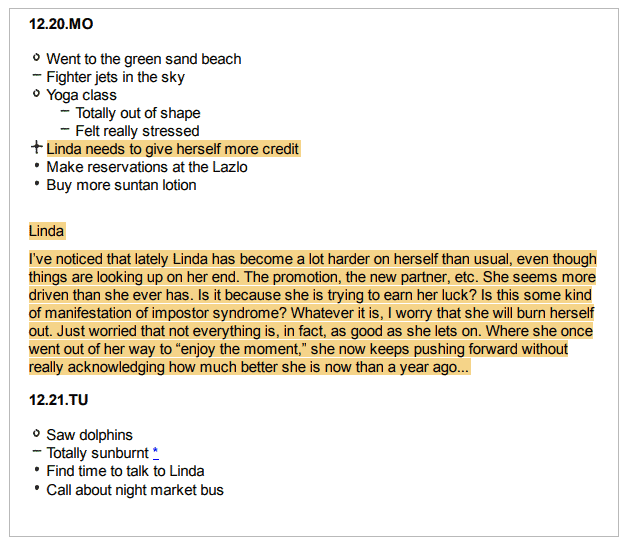
Habit Tracking
Add a small key so that you know what your abbreviations stood for.
Then ad them to your monthly log and simply track them going forward.
C = Cook, R = Read, G = Gym
V. THE END
Bullet Journaling is a self-reflection tool, helping you identify what matters to you and the life you want to lead. Adapt your Bullet Journal to meet your needs. The more you use it, the more beneficial it should become. If that’s not the case, take a moment to ask yourself why.